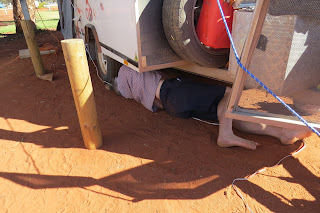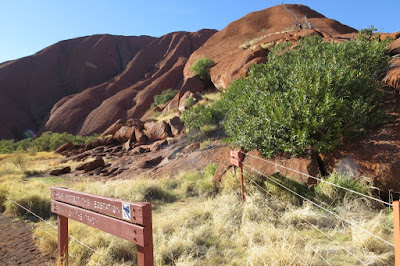At Yulara, the only place near Uluru with accommodation, we had a long wait to check in while 2 groups agonised over not getting adjoining campsites. We ended up in the Overflow area on red dirt but had a powered site and found it OK for the 4 nights we were there.
Yulara is a small tourist town with a good IGA and all facilities, post office, banks, coffee shops ... The town has several levels of tourist accommodation from the very luxurious (Sails in the Desert) to campsites.
After clothes washing, shopping and lunch we drove to Uluru itself, 5 km away and paid $25 each for entry which entitles you to visits on 3 days. The Cultural Centre is very impressive but no photography allowed. We watched an extraordinary documentary there, showing the history of Aboriginal struggles to get control of Uluru. It's not for sale unfortunately, said to contain some politically touchy material.
Still had time for the one hour Kuniya walk which was very easy and surprisingly pretty. The snake-like grooves along the base of the rock are said to show where Kuniya went to Mutitjulu Waterhole.
 | ||||
| Small waterhole |
 |
| DVD we saw showed water cascading all over the rock |
 |
| Comfortable seats were common, often in shelter sheds |
And after all that we did that day, David still had the energy and expertise to get under our trailer and fix the brake cable.
 |
| He was not enjoying the work! |
Today we planned to go on the ranger-guided Mala Walk at 10am, just 2km. We were there early and soon joined by many others with the same goal.
While waiting, everyone looked at the tourists showing off by climbing up the rock despite signs pleading with people not to do so.
The ranger was late, the crowd growing and we decided to go on our own, a good choice as the signage told us all we needed to know. The walk is where the Mala (rufous hare-wallaby) people camped when they first arrived at Uluru. It is centred on Kantju Gorge and has examples of Anangu rock art.
 |
 |
| See the holes made by the mole in the photo below |
 |
| Unusual long white cloud |
We started the 4km Liru walk near the Cultural Centre after this but it just went through mulga with few flowers. Only 26 degrees but felt far too hot. Drove back to Yulara for shopping and fuel.
Paid $39 each to be picked up at a bus stop for a 8:30pm trip to the Field of Light installation. The best thing about it was the actual night sky - brilliant! We wandered in the dark through all these lights and hoped we could find the bus back. Photography without a tripod (banned in case someone tripped on it) was impossible. Some folks paid $245 each for dinner there with a talker to decode the night sky. They came home the same time as we did, leaving around 9:45 and some seeming rather tipsy. Image below copied from internet.
Wednesday 26 July
Drove 53 km to Kata Tjuta (the Olgas). We were going to continue on to Western Australia but decided to look at the Great Central Road, just in case it seemed too hard. Unfortunately, it was. After 3.6 km of bad corrugations, we (and another 4WD) turned back.
 We did 2 short walks at Kata-Tjuta, each less than 3 km return. The first one was the short option for Valley of the Winds as the 7.4 km walk was described as steep, rocky and difficult.This short walk ended with a lookout into the valley, as seen in the photo below.
We did 2 short walks at Kata-Tjuta, each less than 3 km return. The first one was the short option for Valley of the Winds as the 7.4 km walk was described as steep, rocky and difficult.This short walk ended with a lookout into the valley, as seen in the photo below.The hard sections started with a descent into the valley which many younger people did.
There were quite a few pretty flowering plants around.
 |
| Eremophila |
 |
| Ptilotus Mulla Mulla |
 |
| Pandorea doratoxylon once used for spear shafts, a rare plant |
 |
| End of gorge walk |









































No comments:
Post a Comment